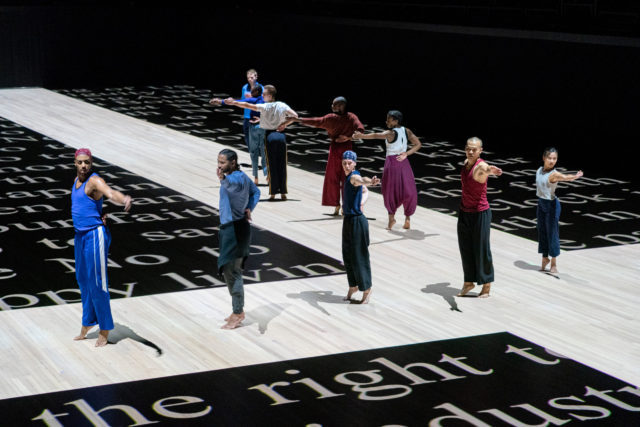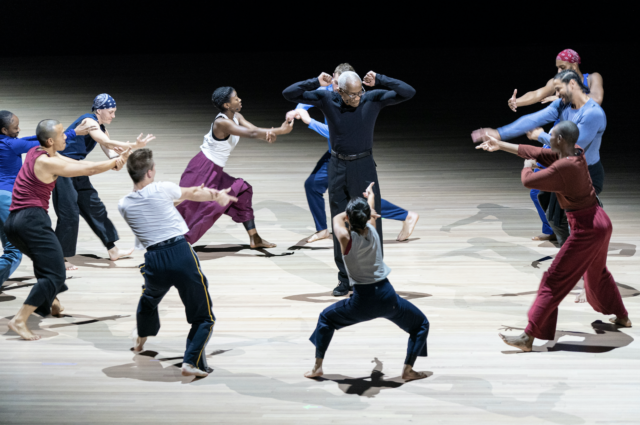
Bill T. Jones’s Deep Blue Sea is set within an illuminating, immersive environment at Park Ave. Armory (photo by Stephanie Berger)
DEEP BLUE SEA
Park Avenue Armory, Wade Thompson Drill Hall
643 Park Ave. at 67th St.
September 28 – October 9, $40
212-933-5812
www.armoryonpark.org
Bill T. Jones is in the midst of yet another well-deserved moment, culminating in the spectacular Deep Blue Sea, continuing at Park Avenue Armory through October 9. During the pandemic, the legendary dancer, choreographer, Kennedy Center honoree, and activist, along with his troupe, the Bill T. Jones/Arnie Zane Company, streamed a reimagined version of 1991’s Continuous Replay. In May, after a one-month delay because of a Covid outbreak in the company, they staged Afterwardsness at Park Ave. Armory, a socially distanced and masked production that addressed racism, police brutality, classism, and the pandemic itself. In July, the documentary Can You Bring It: Bill T. Jones and D-Man in the Waters was released, a thrilling look at Jones’s seminal 1989 piece, D-Man in the Waters, exploring intergenerational tragedy and loss while drawing comparisons between AIDS and other crises.
Delayed a year and a half due to the pandemic, Deep Blue Sea is a one-hundred-minute multimedia meditation on being Black in America. As the audience enters the Wade Thompson Drill Hall, which features a large, rectangular central space with ten rows of rafters, starting about ten feet high, on all four sides, Jones, dressed in his trademark black, is moving determinedly across the floor, almost robotically. Some people recognize him; others walk right past him to their seats, oblivious. It’s Jones’s return to performing for the first time in ten years, when he appeared (nude) in a 2011 iteration of Continuous Replay at New York Live Arts. On every seat is a long sheet of paper with writing on both sides, in Jones’s handwriting; it reads in part: “Thank you, Mr. Melville! / Thank you for the Pip / Thank you for his music / Thank you for his fragile fear / Thank you for his loneliness in the ocean . . . / Thank you for not letting him drown. / Thank you for this floor we are moving on. Thank you for the ocean just now pretending to be a stage. / Thank you, Dr. King! . . . Thank you for words that I can shred, misunderstand, mangle and still they meet the air like singing.”

Bill T. Jones stands in the middle of it all in multimedia Deep Blue Sea (photo by Stephanie Berger)
The sixty-nine-year-old Florida native soon starts a long monologue in which he explains that he was disturbed to discover that, upon revisiting Herman Melville’s Moby-Dick, he had completely forgotten about Pip, the young Black cabin boy aboard the Pequod. “Pip was invisible to me,” he recalls. Using that as a metaphor, Jones, joined by ten dancers, delves into the lack of inclusivity in the word “we” in contemporary society. He incorporates text from W. E. B. DuBois’s The Souls of Black Folk, Rev. Dr. Martin Luther King Jr.’s “I Have a Dream” speech, Kendrick Lamar’s “Never Catch Me,” and Moby-Dick, with live gospel, blues, and hip-hop performed by vocalists Philip Bullock, Shaq Hester, Prentiss Mouton, and Stacy Penson in red costumes and Jay St. Flono in more colorful African-inspired dress. (The costumes are by Liz Prince.) The dramatic score was composed by musical director Nick Hallett, accompanied by an electronic soundscape by Hprizm aka High Priest, Rena Anakwe, and Holland Andrews.
Choreographed by Jones, Janet Wong, and the company — Barrington Hinds, Dean Michael Husted, Jada Jenai, Shane Larson, s. lumbert, Danielle Marshall, Nayaa Opong, Marie Lloyd Paspe, Jacoby Pruitt, and Huiwang Zhang — Deep Blue Sea immerses the audience in a breathtaking visual environment designed by Elizabeth Diller, of Diller Scofidio + Renfro, with award-winning projection designer Peter Nigrini (Here Lies Love, Beetlejuice); the superb lighting is by Robert Wierzel. (You can watch an artist talk with Diller, Nigrini, and Hinds here.) I suggest wearing a white or light-blue mask for an added bonus when it gets dark.
The surprises are many, from a black spotlight following Jones to white spotlights on the other dancers that merge into amorphous bubbles, from mirrors that turn the space into a kind of three-dimensional infinity room to the appearance of a calming, gently rolling ocean. Snippets of text roll beneath the dancers. The face of a boy representing Pip dominates the floor, blinking up at us. Jones refers to the dancers by name several times, giving each their own identity and voice. Wearing everyday clothing, they run across the stage, form into a tight group, and line up on their backs, asserting themselves as individuals and a close-knit group. Jones expands the idea of community with an overly long though visually engaging conclusion in which ninety-nine local people share personal statements that begin, “I know . . . ,” after which the audience is encouraged to come down and mingle, becoming an ever-expanding “we.”
“[Pip] saw God’s foot upon the treadle of the loom, and spoke it; and therefore his shipmates called him mad,” Melville writes in Moby-Dick. “So man’s insanity is heaven’s sense; and wandering from all mortal reason, man comes at last to that celestial thought, which, to reason, is absurd and frantic; and weal or woe, feels then uncompromised, indifferent as his God.” At one point in Deep Blue Sea, the phrase “You can’t turn back” is projected onto the floor, Jones’s uncompromising approach to providing a way forward through indifference.